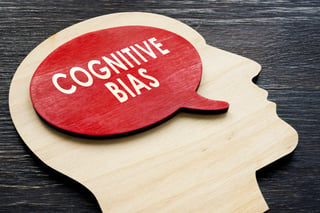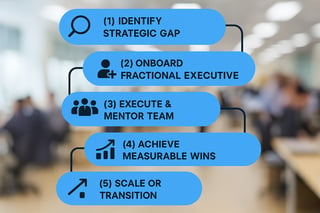Growth Insights for CEOs

AI Search is Here – And it’s Reshaping the Buyer Journey
Part 1 of our four-part series exploring how AI search is transforming visibility, SEO, and digital strategy - and what CEOs need to do now to stay competitive.
| Executive Takeaways |
| Declining web traffic isn’t random - it’s a symptom of changing search behavior. AI search is already impacting over 25% of user journeys - and growing fast If you’re not being cited, you’re missing opportunities-period. |
Recent Posts

Outsider Insights | From Hustle to System: Why More CEOs Are Rebuilding Their Sales Function
Mon, Nov 3, 2025 — Outsider Insights Across Chief Outsiders, we talk to hundreds of CEOs every month. In this new series, we explore the trends and challenges we’re hearing from these discussions – and what you can do if you’re facing the same issues in your business.

Beyond the Buzzwords: How CEOs Can Build a Truly Resilient Business
Wed, Oct 22, 2025 — In every keynote, article, and boardroom conversation, “resilience” gets tossed around as the Holy Grail of leadership virtue. But resilience is more than just surviving economic turbulence—it’s about turning disruption into a competitive edge. Too many CEOs treat resilience as a slogan rather than a strategy. Real resilience is built in advance, not claimed during a downturn. It starts with clarity regarding where you are in the economic cycle, where you’re headed, and how to align your people and resources accordingly.

The Cost of Waiting: Why “Doing Nothing” Is the Most Expensive Strategy
Tue, Oct 7, 2025 — When markets shift, many CEOs adopt a dangerous mindset: Let’s wait and see. On the surface, it feels prudent, even safe. But hesitation quickly becomes the costliest default in leadership—a form of self-sabotage and an expensive compromise. Economic shifts don’t pause until you’re ready. By the time you’re confident the upturn is real—or the downturn has arrived—it’s too late to act decisively. Competitors who moved first have already secured the best opportunities. And you’ll be left wishing you had not waited.
Stay up-to-date with the latest from Chief Outsiders

Becoming the Issachar CEO: Leading with Foresight in a Time of Uncertainty
Tue, Sep 30, 2025 — It’s not every day that a C-suite leader turns to 1 Chronicles for advice, but there’s something here for us. 1 Chronicles chapter 12 describes each of the tribes of the nation of Israel as they moved their allegiance from the house of Saul to the newly crowned King David. The scripture recounts an impressive array of warrior clans ready to fight for their new king, until it reaches the tribe of Issachar, described in verse 32 as “men who had understanding of the times, to know what Israel ought to do.”

5 AI Trends Every CEO Must Act On
Mon, Sep 15, 2025 — Earlier this year, I shared takeaways from Mary Meeker’s Internet Trends Report, which showed how AI is reshaping business at a macro level. Building on that, Google Cloud’s 2025 AI Trends Report highlights five forces that will directly impact companies in the year ahead. AI is no longer experimental. It is restructuring markets, reshaping customer expectations, and redrawing competitive boundaries. Here are five AI trends CEOs are preparing for now:

From Recovery to Recession: A CEO’s Guide to Thriving Through Economic Shifts
Tue, Sep 9, 2025 — When markets shift—and they always do—the winners are those who don’t wait to react. They move first, and fast. No matter which of the four cycles you’re currently experiencing, one constant remains true: waiting for things to be more favorable is a bad strategy. Additionally, doing nothing is not an option. Companies that anticipate, plan, and act in alignment with their current business phase can maintain resilience, capture opportunities, and outperform competitors who simply “wait it out.”

From Economic Insight to Growth Strategy: What CEOs Should Do Now
Tue, Aug 26, 2025 — At our most recent CEO Growth Talks, I spoke with Taylor St. Germaine, Senior Economist at ITR Economics. The timing couldn’t have been better — the latest GDP numbers had just been released, and Taylor broke down what they mean for CEOs planning growth. As always, ITR brought a clear and fact-based perspective. The economy is growing. Consumer spending is strong. And while some industries are facing headwinds, opportunities abound for leaders who are ready to act. But the real question for CEOs isn’t just what the economy looks like. It’s: how do you prepare your business to grow in this environment — and the one coming next?

Think Like Your Customer: 8 Cognitive Biases Every CEO Should Know
Mon, Aug 25, 2025 — Human beings like to think we make decisions logically. But research in behavioral science and neuroscience tells a different story: up to 95% of decisions are made unconsciously, then justified rationally. Cognitive biases shape every decision, often before logic enters the picture. These shortcuts drive customer responses to marketing, pricing, and branding, sometimes in ways that defy prediction.

The Midmarket CEO’s Guide to Hiring a Fractional Executive
Mon, Aug 25, 2025 — Different Kind of Hiring In a business climate where agility is currency, fractional executives have moved from a niche solution to a strategic growth lever. For midmarket companies—large enough to require senior leadership, yet lean enough to feel every overhead dollar—fractional executives offer an appealing mix of expertise, flexibility, and speed.
.png?width=1500&height=398&name=CO_Corporate%20Logo%202021_4C_HOR_FNL-1%20(1).png)